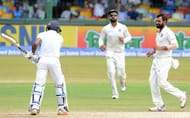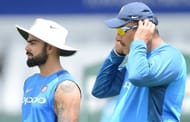
The year was 2014. The venue Wellington. India were playing New Zealand.
After dismissing the hosts out for 192, the batsman had done their bit by putting up 438 runs to give the bowlers enough time to force a win.
At 93 for 5 in the 41st over, only one result seemed possible.
Until. Until Brendon McCullum and BJ Watling decided it was time to show some pluck.
The duo strangled the visitors for the next 120 overs to ensure they had to continue their wait for an overseas win, along with further plummeting the faith of the average Indian fan on this team.
That frustration carried on for the next two tours that followed, in England and Australia. But something significant happened in the latter.
MS Dhoni decided he had enough of Test cricket and Virat Kohli ushered in a new era.
Six months later, India went to Bangladesh for a one-off Test and once again put up a big score on the board.
All eyes were now on the bowlers and how Kohli would use them.
A couple of days later, the answer arrived and emphatically so as the hosts were bowled out for 256 runs.
Little did we know then, that these were the signs of things to come.
In each of the next eight Test series, India have bowled out the opposition at least once in every completed Test that they have played and have suffered just two losses when they have dismissed them twice.
As a result of that, they have won every series, that they have played, proving the notion many believe that it's the bowlers who win you games, more often than not.
So what has changed?
For starters, the fast bowlers seem to have matured and seem to have a better understanding, a prompt method to get wickets.
Some of the pitches in the home season offered something for all and on such decks, the bowlers were willing to toil away.
Umesh Yadav took 11 wickets and averaged 49 with the ball in the 2014/15 season.
In the 2016/17 season, that wicket column almost doubled and the average reduced by 13 to come down to 36.

In the 3 Tests that he played in the 2014/15 season, Mohammed Shami took 15 wickets in 3 matches at an average of 35
In the 2016/17 season, he played 6 Tests, picking 18 wickets at an average of 27.
Most of the talk, however, surrounded around Ravindra Jadeja and R Ashwin, who made full use of the help on offer.
When the challenge gets tougher than what it is now in Sri Lanka, the learnings from those days of toil could come in handy.
There is another element, which has not got the coverage that it should.
Exactly 3 years ago, India found itself in doldrums in England. The batting had collapsed. The bowling looked toothless. It just seemed like the players did not wish to be there.
The BCCI sent Ravi Shastri, Sanjay Bangar, Bharat Arun and R Sridhar as the Team Director, batting, bowling and fielding coaches respectively.
What began as some kind of a reactive measure to the misery turned into a wonderful partnership, where both parties formed an extremely workable relationship.
During Arun’s maiden stint with the side between August 2014 and March 2016, India played 12 Tests, winning 5 of them.
In each of them, the bowlers put in a collective effort to take 20 wickets.
The team lost 3 matches in this period, however, in one of those games, it was the bowlers who put the team on top against Sri Lanka in Galle, only for the batsmen to fall for the guile of Rangana Herath in the final innings of the Test.
The lessons learnt under Arun were carried forward into the home season, where the team lost just once in 13 matches.
Hence, it was a touch surprising when he did not get an extension along with Bangar and Sridhar last year. The board felt that with Anil Kumble at the helm, he would be able to handle the quicks as well along with the spinners.

Familiarity helps and Ravi Shastri, when he was made head coach of the side last month, spoke about why he wanted Arun back as the former India pacer knew most of the current crop of the bowlers and gave the example of the 2015 World Cup, where India bowled out every team except Australia in the semifinal.
The last and perhaps an underrated factor to the success of the bowlers is Virat Kohli.
Having a leader who has constantly spoken about the need to take 20 wickets and accordingly given the bowlers what they wanted would have surely helped the quicks get a better idea about the lengths to bowl.
Kohli likes pace and it is evident from the kind of selections he makes in the longer format.
As per the revised schedule, India will travel to South Africa in January next year. The test for the working the last few years will arrive there for this very exciting looking Indian bowling unit.
Follow IPL Auction 2025 Live Updates, News & Biddings at Sportskeeda. Get the fastest updates on Mega-Auction and cricket news
